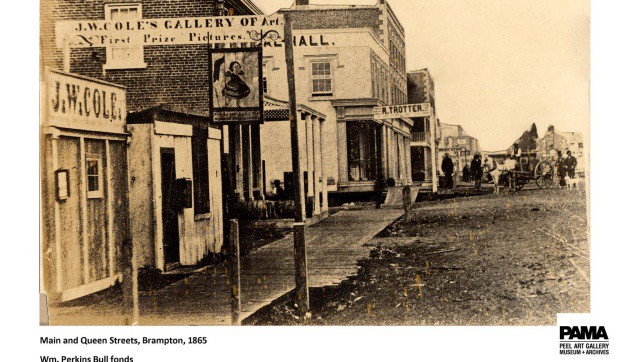Brampton’s Art Gallery and Museum Gets Massive New Archival Collection
Published November 30, 2017 at 4:57 am

It’s no secret that Peel Region is packed with history, and now, Peel Art Gallery Museum and Archives (PAMA) has received a new haul of archival material, dating back to the 1800s.
It’s no secret that Peel Region is packed with history, and now, Peel Art Gallery Museum and Archives (PAMA) has received a new haul of archival material, dating back to the 1800s.
And it’s — of course — really cool! Whether you’re a history buff, you’ve lived in Peel Region for a long time, you like art, or you’re fascinated by Canadian history and Peel Region’s history in general, this one’s for you.
The William Perkins Bull Historic Collection was recently reconstituted and donated to PAMA, the art gallery and museum announced earlier this week.
The entire collection includes about 48 metres of archival material, 245 historic artifacts, and 66 works of art.
We told you it’s massive.
According to PAMA, these materials are used by researchers and archives staff every day at PAMA, and collection records are used for publications, exhibits, research, and even social media.
“This exceptional collection of archival records, art and historical objects is a precious legacy,” said PAMA’s manager, Marty Brent. “It is an unparalleled window into Peel’s and Canada’s past.”
There’s a pretty interesting history behind how this collection came to be:
The collection revolves around the Bull family, who moved to Peel County after 1870, when William was born. The Bulls established a cattle farm on what’s now Peel Village.
William Perkins Bull had quite a successful life – he practiced law as a young adult, was Timothy Eaton’s personal solicitor, and became the youngest King’s Counsel in the British Empire in 1908.
“During WW1 the Bull family was living in England and established an ‘open house’ for Canadian officers overseas,” says PAMA. “This became the Perkins Bull Hospital for Convalescent Canadian Officers. Among their many Canadian patients were Canadian solider, diplomat, Governor General of Canada (1959 – 1967) Georges Vanier and decorated World War I flying ace Billy Bishop.
When Perkins Bull came back to Canada, he was in a serious car accident. Then, he wrote a family history. That brief family history led to a huge and comprehensive history project, wherein Perkins Bull amassed this collection.
“On behalf of the Perkins Bull Foundation, may I express appreciation to the Peel Art Gallery, Museum and Archives (PAMA) for its continued stewardship of my grandfather’s remarkable collection of art, artifacts, and archival material, amassed over many years and through a multitude of experiences,” said Professor Thomas H.B. Symons. “I cannot think of anywhere more appropriate for this collection to be housed and made available to future generations seeking to learn more about the history and heritage of Peel County, of Ontario and, indeed, of Canada.”
PAMA has highlighted a few items from the collection:
If you’ve ever been to Streetsville and felt its charm, you’ll be interested to know that the material includes a painting of Streetsville circa 1910 by Gertrude Spurr Cutts, who was known for her romantic pastoralism — her evocative paintings of rural landscapes.
There are also some Caledon landscape paintings, one by James Richard Tate — South of Alton, circa 1935 — and one by Frederick G. Banting, Harvest Field in Albion and Barn Near Palgrave, 1933.
Here’s something really unique — there is a pair of brass knuckles in the collection from around 1845, owned by Peel County Police Constable James Smith in the 1850s.
“Used to protect one’s hands in fist-fights, brass knuckles have long been illegal to use in Canada. James Smith went on to become the Peel County Inspector of Weights and Measures in 1867,” says PAMA.
Three illustrated maps of Albion, Chinguacousy, and Caledon Townships circa 1933 have lots of visual references to folklore and history in the area, drawn by University of Toronto student Gertrude Kemp. On the maps, there are “fanciful depictions of a sea monster living in Heart Lake, a rower paddling through flooded Brampton downtown, and prospectors looking for gold near the village of Cataract.” Very fun.
Patient registers and guest books from The Perkins Bull Convalescent Hospital for Canadian Officers, 1916-1919, have also found a permanent home at PAMA. This was at Perkins Bull and his wife Maria’s home in London, England, which became a place of treatment and respite for Canadian Officers. King George V and Queen Mary even dropped by.
It’s always fun to take a trip to PAMA and check out what’s new. For details on exhibits, click here.
Photo courtesy of PAMA on Facebook
insauga's Editorial Standards and Policies advertising






